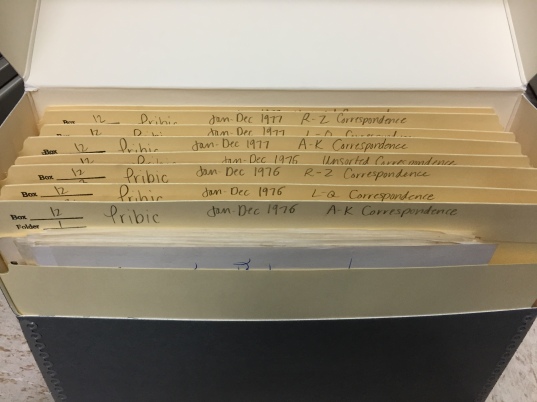 Everyone enters a field of work for one reason or another. For me, pursuing a Masters of Library and Information Studies began from a desire to be an archivist, a type of information professional that is largely underrated, misunderstood, or even unheard of by the public. The mystery regarding the profession drew me in initially. Popular culture depicts archives as dark and secluded repositories with strict access restrictions guarded by a gatekeeper, hesitant to divulge any of the archives’ secrets. Think of the less-than-helpful associate in the Jedi Archives who turns Obi-Wan away in Star Wars Episode II; she might as well have shushed him while she was at it!
Everyone enters a field of work for one reason or another. For me, pursuing a Masters of Library and Information Studies began from a desire to be an archivist, a type of information professional that is largely underrated, misunderstood, or even unheard of by the public. The mystery regarding the profession drew me in initially. Popular culture depicts archives as dark and secluded repositories with strict access restrictions guarded by a gatekeeper, hesitant to divulge any of the archives’ secrets. Think of the less-than-helpful associate in the Jedi Archives who turns Obi-Wan away in Star Wars Episode II; she might as well have shushed him while she was at it!
The reality of archives is quite the opposite. In all of my experiences, archivists are more than happy to help you in your research and want to share the collections as much as possible with the public. That’s why they collect it all. In order to do so, however, they must establish order.
 In a job where creating order out of disorder is a top priority, the profession tends to attract many an OCD history buff. There’s something viscerally satisfying about organizing a dusty old mess of papers into a neat collection of documents in acid-free folders, legibly labeled for ready accessibility.
In a job where creating order out of disorder is a top priority, the profession tends to attract many an OCD history buff. There’s something viscerally satisfying about organizing a dusty old mess of papers into a neat collection of documents in acid-free folders, legibly labeled for ready accessibility.
 Many steps go into creating this order, however. After gaining legal custody of the documents, the archivist has to “gain intellectual control,” which is a sophisticated way of saying “learn exactly what kind of stuff is in the collection.” In order to do this, one must comb through the contents, which could take a very long time depending on how many linear feet the collection is, and create an inventory. The collection I’ve been “gaining intellectual control” of is called the Douglas and Jeannette Windham Papers, which contains the papers and publications of Douglas and Jeannette Windham, a distinguished FSU alumni couple. I’ve listed the materials that are in the collection, including personal papers, correspondence, academic articles, photographs, and professional reports. Once intellectual control is established, I can work with the archivist to determine a plan for order and begin to folder the contents into acid-free folders. A.K.A. the fun part! The kind of fun that is on par with labeling the shelves of your pantry, or color-coding your closet. (Yes, this is how I live).
Many steps go into creating this order, however. After gaining legal custody of the documents, the archivist has to “gain intellectual control,” which is a sophisticated way of saying “learn exactly what kind of stuff is in the collection.” In order to do this, one must comb through the contents, which could take a very long time depending on how many linear feet the collection is, and create an inventory. The collection I’ve been “gaining intellectual control” of is called the Douglas and Jeannette Windham Papers, which contains the papers and publications of Douglas and Jeannette Windham, a distinguished FSU alumni couple. I’ve listed the materials that are in the collection, including personal papers, correspondence, academic articles, photographs, and professional reports. Once intellectual control is established, I can work with the archivist to determine a plan for order and begin to folder the contents into acid-free folders. A.K.A. the fun part! The kind of fun that is on par with labeling the shelves of your pantry, or color-coding your closet. (Yes, this is how I live).
The ordering continues when the boxes are stored in the stacks which are kept under strict environmental regulations in order to best preserve the archival materials from accelerated deterioration. The last step of creating order in the archives is to write the online finding aid so potential researchers can get an understanding of what is in the collection. This helps the collections get used more, which is, after all, the whole point in the first place! And there you have it: archives de-mystified.